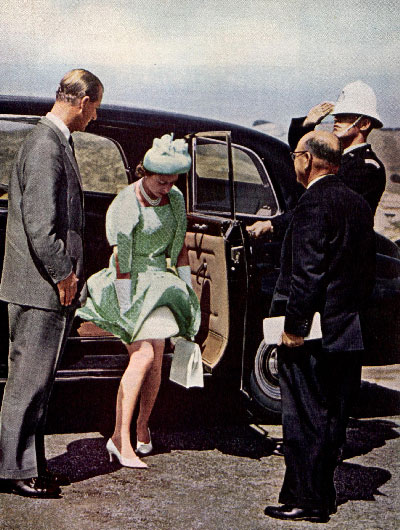Finding Some Good in the Royals

With three recent events, the British Royal Family has once again moved into the media spotlight. First came the announced engagement of Prince William, Queen Elizabeth II’s grandson. Then came the release of the movie The King’s Speech, about King George VI and his struggle to master his chronic stutter. Just yesterday, the car carrying Prince Charles and his consort was attacked by college students rioting over tuition hikes.
Perhaps it’s inevitable that any mention of the ‘royals’ in America prompts the old debate of whether there’s any justification for a monarchy today. The duties of the queen, and all her family members, are entirely ceremonial. They are living symbols of a long tradition. But they are symbols and this is an literal age.
Americans should have a natural prejudice against kings and queens, or any inherited privilege. The United States only came into existence after fighting for independence from King George III — Queen Elizabeth’s great, great, great, great grandfather. Thomas Jefferson branded that king an “absolute tyrant” and believed that aristocracy was a “mischievous ingredient in government, and provision should ever be made to prevent its ascendancy.” In the following centuries, as the U.S. and England competed for global prominence, American writers, teachers, and politicians frequently denounced the English throne, and its occupants — “those pets of privilege,” as Mark Twain called them.
Yet the American attitude toward the Royals is curiously ambivalent. Millions of Americans became admirers of Princess Diana. For some, she embodied the fairytale romance of the princess bride. But many others admired what they perceived as her grace, poise, and commitment to social causes. Americans may be biased against aristocracy, but we are drawn to any display of heroism and virtue. We seek role models of courage, judgment, maturity, and dedication. Like it or not, we have often found these democratic qualities among the last people we would expect — the ultra-privileged.
The Post published several articles about the British royal family in the 20th century. Every one of them noted approvingly how England’s kings and queens displayed such American virtues as modesty, simplicity, and informality. The authors of “King George” in 1933 praised the frugality of the King George V and Queen Mary.
[The royal family] ungrudgingly fulfilled the countless ceremonial duties falling to their share. … They were content to live self-effacingly with the shadows for a while. Their expenditures were modest, considering their rank. The small dress bills [of Mary] would have amazed women of the New York Four Hundred, it was said at the time. Indeed, even when she became Princess of Wales, the future Queen Mary still most creditably refused to be extravagant.
King George V, they concluded, didn’t even talk like a king.
[His] an unstilted style of saying things, far removed from the old-time public utterances of royalty.
His son, the Prince of Wales — and later, briefly, King Edward VIII — was a nice guy with class:
charming, urbane, with a delightful suavity of manner, [he] puts everybody at ease, allaying all feelings of natural shyness and timidity.
His brother, the future King George VI, had a natural affinity for the commoner:
With the bluffness of the sailor … he had about him a certain “hale-fellow-well-met” air. The straight-from-the-shoulder simplicity with which he talked … rang delightfully true. Pretense was so alien to him … one could see that here was a prince who, in mixing with people, could not easily conceal his liking for them.
If the Post writers purred in their assessment of the kings, they nearly swooned over young Queen Elizabeth II. Even before she had a chance to prove herself as monarch, journalists were pulling out their most rhapsodic prose for her. Paul Gallico promptly declared her “a young, gracious, and really lovely queen.” Jan Morris gushed —
There is no getting away from the mystique of the English monarchy. … I defy any man of sensibility, still less any woman, to resist the magic of this extraordinary lineage, when you meet it face to face. It is a phenomenon unique in its kind. Profound your instincts of equality may be, and blaring your dislike of snobbery, but when it comes to the royal point you will almost certainly succumb. An inescapable mystic allure invests the queen of England when you see her standing in her own palace, a handsome woman in herself, and in her significance marvelously alluring.
One of the classic European experiences of our time is to wander on to Pall Mall in London one high summer day and glimpse above the shoulders of the crowd this royal lady, in a tricorn hat and scarlet tunic, pink-cheeked and grave-faced, side-saddle on a tall chestnut, leading her glittering Horse Guards toward Admiralty Arch. Here we see a last figure of towering romance, of folk loyalties and earth instincts, a last shining reminder of the world that was, before reality broke in.
Reality, in fact, never broke in. It was there all along. All that display and ceremony, the fancy dress and glittering guards, were only incidentally meant to impress commoners and, later, attract tourists. The monarch’s true purpose, as Malcolm Muggeridge pointed out in his 1957 Post article “Does England Really Need a Queen?” has been, and continues to be, political.
Next: The Queen’s Real Job
This post was updated on September 10, 2015.